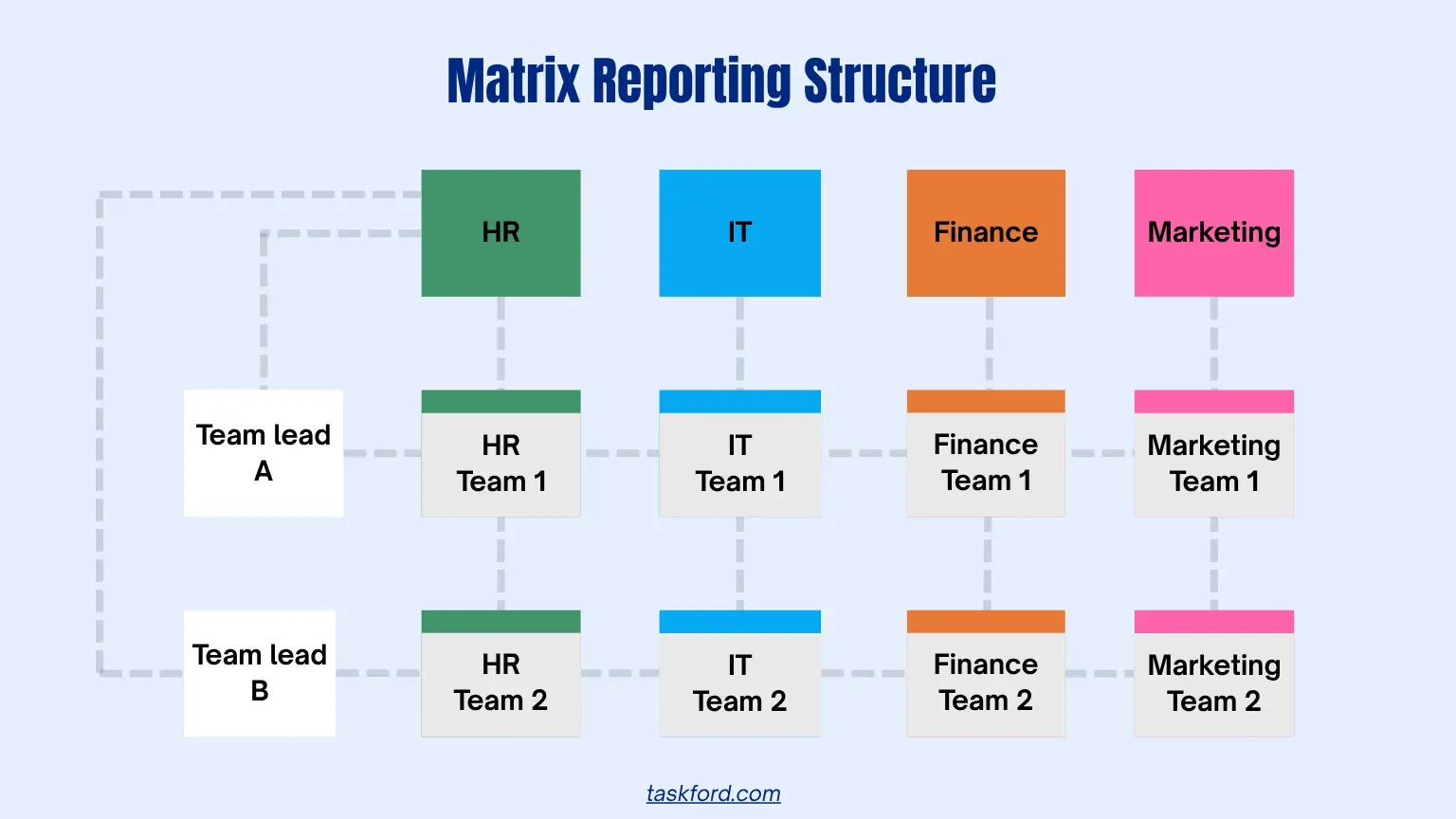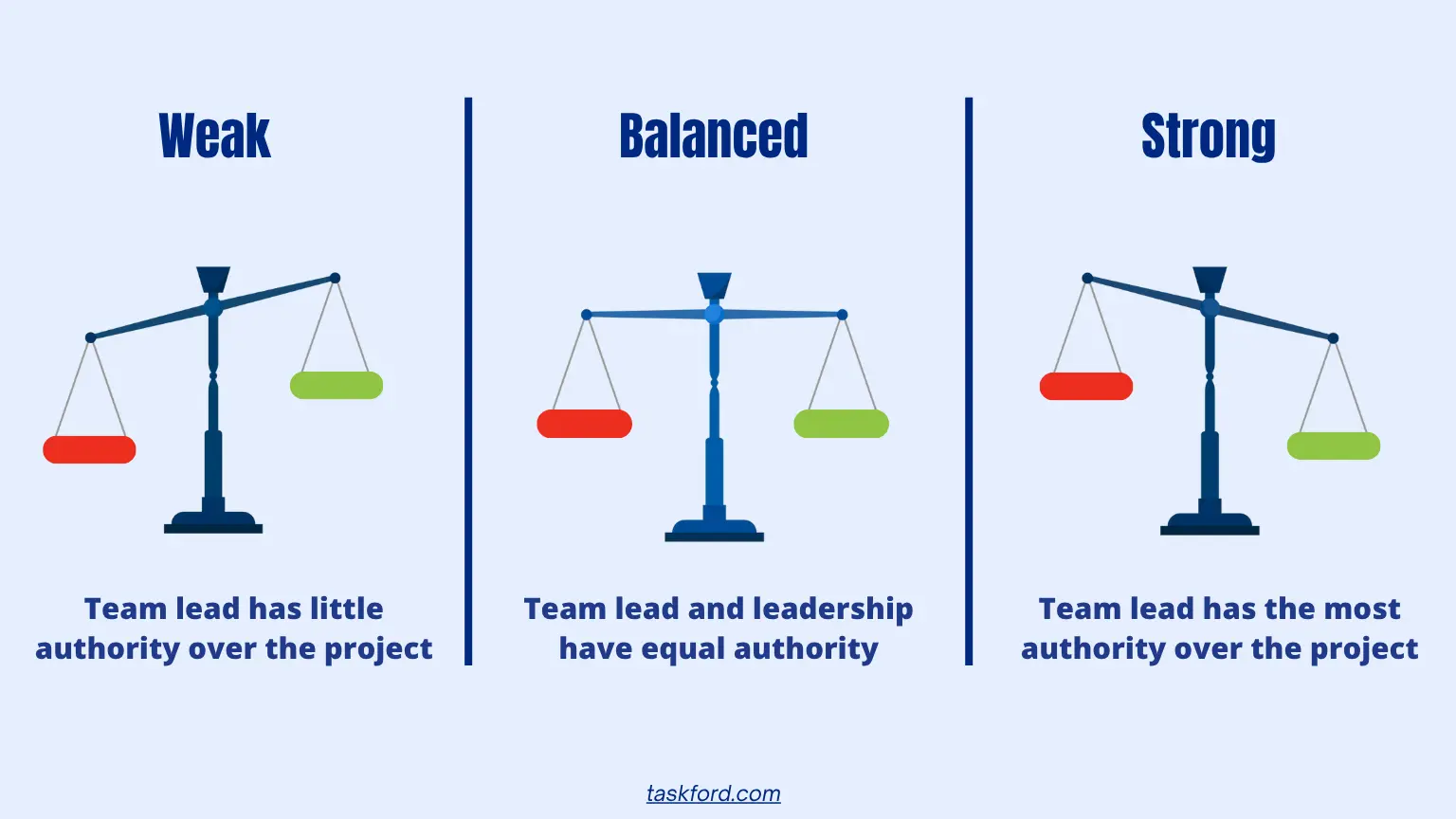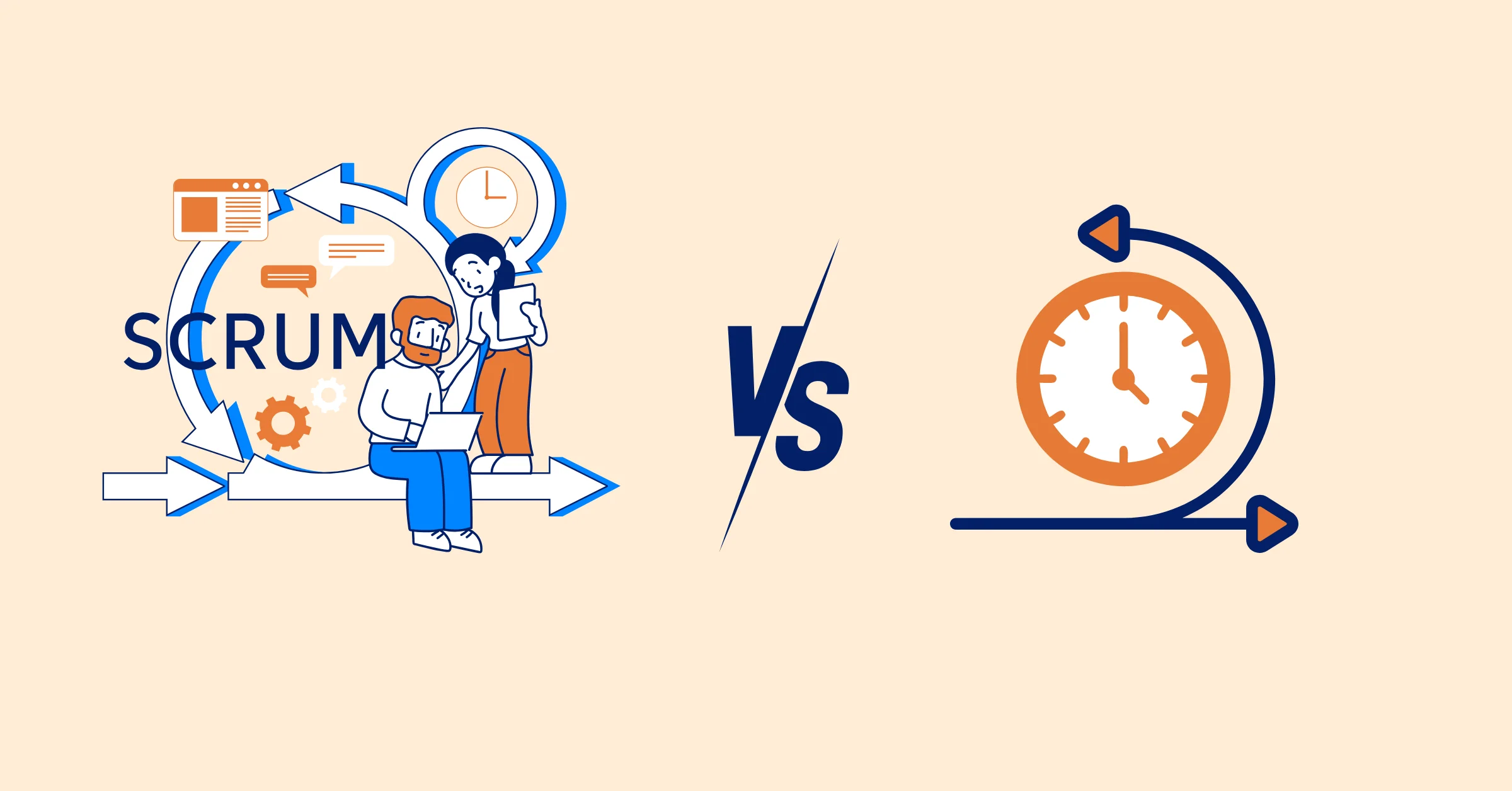Matrix Organization Structure: Types, Benefits, and Challenges
Discover the types, benefits, and challenges of the matrix organization structure, and learn how TaskFord’s project management tools can optimize its implementation.
Modern businesses face the challenge of managing complex projects while leveraging specialized expertise across departments, making innovative organizational structures essential for success. The matrix organization structure has emerged as a powerful solution, blending flexibility and collaboration to drive project management efficiency. By enabling cross-functional teams and dynamic resource allocation, it aligns organizational goals with project objectives. However, its complexity requires careful navigation to avoid pitfalls.
In this comprehensive blog, we explore the types, benefits, and challenges of the matrix organization structure, offering deep insights for businesses and project managers considering its adoption. We also highlight how TaskFord’s project management tools empower teams to thrive within this structure.
Understanding Project Management
Project management is the discipline of planning, organizing, and executing tasks to achieve specific goals within defined constraints, such as time, budget, and scope. It serves as the backbone of matrix organizations, enabling project managers to coordinate cross-functional teams, manage resources, and deliver outcomes that align with strategic objectives. In a matrix structure, project managers are central to resolving conflicts, aligning priorities, and ensuring project success amidst dual reporting lines.
To dive deeper into what project management is, here's our Project Management Guide.
What Is a Matrix Organization Structure?

A matrix organization structure is a hybrid model that integrates functional and project-based frameworks. Employees report to two or more supervisors, typically a functional manager, who oversees their departmental role and expertise, and a project manager, who drives specific initiatives. This dual-reporting system creates a grid-like structure, giving rise to the term “matrix.”
Originating in the 1950s in industries like aerospace, technology, and defense, the matrix structure was developed to manage complex projects requiring diverse skill sets across departments. Unlike traditional hierarchies, where authority flows vertically through a single chain of command, the matrix enables horizontal collaboration, allowing organizations to tackle multifaceted projects while leveraging functional expertise.
This structure is widely adopted in sectors such as construction, consulting, IT, software development, and marketing, where cross-departmental collaboration is essential. For example, a technology firm might assign software engineers from a functional department to multiple client projects while maintaining their roles within the engineering team, ensuring both technical excellence and project delivery.
Key Characteristics of a Matrix Organization
- Dual reporting lines: Employees answer to both functional and project managers, balancing departmental and project responsibilities.
- Cross-functional teams: Teams are formed by drawing talent from various departments to address specific project needs.
- Dynamic resource allocation: Resources and personnel are shared across projects, maximizing utilization and flexibility.
- Project management focus: Projects drive decision-making, with clear timelines, budgets, and deliverables guiding team efforts.
Types of Matrix Organization Structures
Matrix organizations vary based on the distribution of authority between functional and project managers. The three primary types (weak, balanced, and strong) cater to different organizational needs and project demands.

1. Weak Matrix Organization
In a weak matrix, functional managers hold primary authority, while project managers serve as coordinators or advisors with limited decision-making power. Employees remain primarily aligned with their functional departments, and project managers rely on influence to secure resources and commitment.
- Best for: Organizations transitioning from a functional structure or those prioritizing departmental expertise over project goals, such as traditional manufacturing firms.
- Example: A manufacturing company where mechanical engineers report primarily to the engineering department but contribute to projects led by a project coordinator with minimal authority.
- Advantages: Maintains strong functional expertise, clear departmental hierarchies, and consistent technical standards.
- Challenges: Project managers may struggle to secure resources or enforce deadlines, leading to potential delays or conflicts.
2. Balanced Matrix Organization
In a balanced matrix, authority is shared equally between functional and project managers. Employees report to both, and decision-making requires collaboration between the two roles. This structure promotes teamwork but can create ambiguity if roles and priorities are not clearly defined.
- Best for: Organizations managing multiple cross-functional projects, such as consulting firms, marketing agencies, or product development companies.
- Example: A marketing agency where a graphic designer reports to both a creative director for departmental tasks and a campaign manager for a client project, balancing creative standards with campaign deadlines.
- Advantages: Encourages collaboration, balances resource allocation, and fosters alignment between functional and project goals.
- Challenges: Potential for power struggles or confusion if communication channels are unclear or priorities conflict.
3. Strong Matrix Organization
In a strong matrix, project managers hold primary authority, with functional managers providing support and resources. Employees are more aligned with project goals, and project managers have greater control over resource allocation, timelines, and deliverables.
- Best for: Project-driven industries like construction, IT, or software development, where meeting project deadlines and deliverables is paramount.
- Example: A construction firm where architects and engineers report primarily to a project manager overseeing a building project, with functional managers ensuring compliance with technical standards.
- Advantages: Enhances project focus, accountability, and timely delivery of outcomes.
- Challenges: Functional managers may feel sidelined, and employees may experience divided loyalties between project and departmental demands.
Benefits of a Matrix Organization Structure
The matrix structure offers significant advantages, particularly for organizations managing complex projects or operating in dynamic, competitive industries. Below are the key benefits, with a focus on their impact on project management and organizational efficiency.
1. Optimized Resource Utilization
Matrix organizations maximize resource efficiency by allowing employees to contribute to multiple projects. Instead of being confined to a single department, skilled professionals apply their expertise where it’s needed most. For example, a data scientist in a tech firm can support both a product development initiative and a marketing analytics project, amplifying their impact across the organization.
This flexibility reduces idle time, ensures optimal use of specialized skills, and enables project managers to access the right talent at the right time, improving project outcomes and organizational agility.
2. Enhanced Cross-Functional Collaboration
By breaking down departmental silos, the matrix structure fosters collaboration across functions, bringing together diverse perspectives to drive innovation. Teams composed of members from engineering, marketing, finance, or other departments create holistic solutions that align with organizational goals.
For instance, a product launch team combining designers, developers, and marketers can deliver a cohesive campaign that balances technical quality, user experience, and market appeal. This collaborative approach strengthens project management by ensuring all aspects of a project are addressed.
3. Flexibility in Project Management
Matrix structures excel in environments where priorities shift rapidly. Project managers can quickly assemble teams tailored to specific project needs, adjusting resources as demands evolve. This adaptability is critical in industries like IT or consulting, where client requirements or market conditions can change abruptly.
The structure also supports concurrent projects, allowing organizations to pursue multiple initiatives without overextending resources. Project management tools like TaskFord, Asana and ClickUp enhance this flexibility by providing visibility into resource availability, task progress, and project timelines.
4. Alignment of Functional and Project Goals
The matrix structure integrates functional expertise with project objectives, ensuring both technical quality and project deliverables are achieved. Functional managers maintain departmental standards, while project managers drive timelines and outcomes. This dual focus aligns individual contributions with broader organizational goals.
For example, in a pharmaceutical company, researchers can work on a drug development project while adhering to rigorous scientific standards set by their functional manager, ensuring innovation without compromising quality.
5. Employee Development and Engagement
Matrix structures expose employees to diverse projects and roles, fostering skill development and career growth. Working under multiple managers provides insights into different business areas, enhancing versatility and marketability.
The collaborative nature of the matrix also boosts engagement by giving employees ownership over projects. This is particularly valuable in creative or knowledge-driven industries, where autonomy, variety, and meaningful contributions drive motivation and job satisfaction.
6. Improved Communication and Knowledge Sharing
The matrix structure encourages open communication across departments, facilitating knowledge sharing and best practices. Employees working on cross-functional teams gain exposure to new methodologies, tools, and perspectives, which can enhance overall organizational capability.
For example, an engineer collaborating with a marketing team on a product launch may learn about customer needs, while marketers gain insights into technical constraints, creating a more cohesive and informed workforce.
Challenges of a Matrix Organization Structure
While the matrix structure offers significant benefits, it also presents challenges that require careful planning and management. Below are the primary obstacles and practical solutions to address them.
1. Role Ambiguity and Confusion
Dual reporting lines can create uncertainty about priorities and responsibilities. Employees may struggle to balance the demands of functional and project managers, especially if expectations conflict. For instance, a designer might face pressure from a functional manager to focus on departmental tasks while a project manager pushes for project deadlines.
Solution: Establish clear role definitions through organizational charts, job descriptions, and guidelines outlining responsibilities. Regular check-ins, team meetings, and project management tools like TaskFord can align priorities and clarify expectations across reporting lines.
2. Power Struggles Between Managers
In balanced or strong matrices, conflicts may arise between functional and project managers over resource allocation or decision-making authority. A functional manager might resist releasing a key employee to a project, citing departmental priorities.
Solution: Foster a collaborative culture and strong leadership to mediate conflicts. Senior management should align functional and project goals, while project management tools provide transparency into resource availability, reducing disputes and ensuring equitable allocation.
3. Increased Administrative Complexity
Managing a matrix structure requires robust coordination and communication. Tracking employee assignments, project progress, and departmental goals across multiple projects can be time-consuming, particularly in large organizations.
Solution: Invest in project management software to centralize communication, track tasks, and monitor resources. TaskFord’s platform offers features like task assignment, progress tracking, and resource planning to simplify matrix operations.
4. Employee Burnout
The demands of reporting to multiple managers and juggling multiple projects can lead to stress and burnout. Employees may feel overwhelmed by competing priorities or stretched thin across assignments.
Solution: Monitor workloads and distribute tasks equitably to prevent overextension. TaskFord’s time tracking and task management features help managers identify overburdened employees and balance assignments, mitigating burnout risks.
5. Slower Decision-Making
The collaborative nature of the matrix can slow decision-making, as multiple stakeholders must align on priorities. This is particularly true in balanced matrices, where authority is evenly split.
Solution: Establish clear decision-making protocols and empower project managers to make timely calls when necessary.
6. Potential for Misaligned Priorities
In a matrix structure, functional and project managers may have differing priorities, leading to misalignment. For example, a functional manager might prioritize long-term skill development, while a project manager focuses on immediate deliverables.
Solution: Align organizational objectives through regular strategic reviews and clear communication of goals.
How TaskFord Supports Matrix Organizations

TaskFord’s project management platform is designed to address the complexities of matrix organizations, empowering teams to collaborate effectively and achieve project goals. Here’s how TaskFord enhances matrix operations:
- Centralized task management: Assign tasks, set deadlines, and track progress across cross-functional teams, ensuring clarity in dual-reporting structures and reducing role ambiguity.
- Resource visibility: View real-time resource availability to allocate personnel efficiently, minimizing conflicts between functional and project demands.
- Real-time collaboration: Enable team members to share updates, documents, and feedback instantly, fostering seamless cross-departmental teamwork.
- Customizable dashboards: Monitor project milestones, budgets, and team performance, providing transparency in complex matrix environments.
- Time tracking and workload management: Identify overworked employees and balance workloads to prevent burnout, ensuring sustainable productivity.
- Reporting and analytics: Looking through insights into project progress, resource utilization, and team performance, supporting data-driven decisions in matrix settings.
By providing a robust project and resource management, TaskFord helps matrix organizations navigate challenges like role ambiguity, resource conflicts, and administrative complexity while maximizing the benefits of flexibility, collaboration, and efficiency.
Best Practices for Implementing a Matrix Organization
To successfully adopt and manage a matrix structure, organizations should follow these best practices:
- Define clear roles and responsibilities: Use organizational charts, job descriptions, and guidelines to clarify reporting lines and expectations for functional and project managers.
- Invest in training and onboarding: Educate employees and managers on matrix management principles, emphasizing collaboration, communication, and conflict resolution.
- Leverage technology: Use project management tools to centralize communication, track tasks, and manage resources effectively across projects and departments.
- Foster a collaborative culture: Promote open communication, teamwork, and mutual respect to align functional and project goals and minimize conflicts.
- Monitor and adjust: Regularly assess the matrix structure’s effectiveness through employee feedback, performance metrics, and project outcomes, making adjustments as needed.
- Prioritize change management: Prepare teams for the transition to a matrix structure through clear communication, stakeholder buy-in, and ongoing support to address resistance or confusion.
Conclusion
The matrix organization structure is a powerful framework for businesses seeking to balance functional expertise with project-driven goals. By enabling optimized resource utilization, enhanced collaboration, and flexibility in project management, it supports innovation and efficiency in dynamic industries.
By adopting best practices and leveraging technology, businesses can harness the full potential of the matrix structure, achieving agility, alignment, and exceptional project outcomes.
Learn more
- What Does A Project Manager Do? A Guide to Advancing Your Career
- The Ten Types of Project Managers: Roles, Skills, and Work Environments
- 80 Key Project Management Terms You Should Know
Making work simpler,
smarter, and more connected
Join our waitlist and be notified first.

Related Blog
Subscribe for Expert Tips
Unlock expert insights and stay ahead with TaskFord. Sign up now to receive valuable tips, strategies, and updates directly in your inbox.

![7 Must-Have Project Management Documents Every PO Should Know [Free Templates]](https://taskford.com/marketing/blog/project-management-documents.webp)




